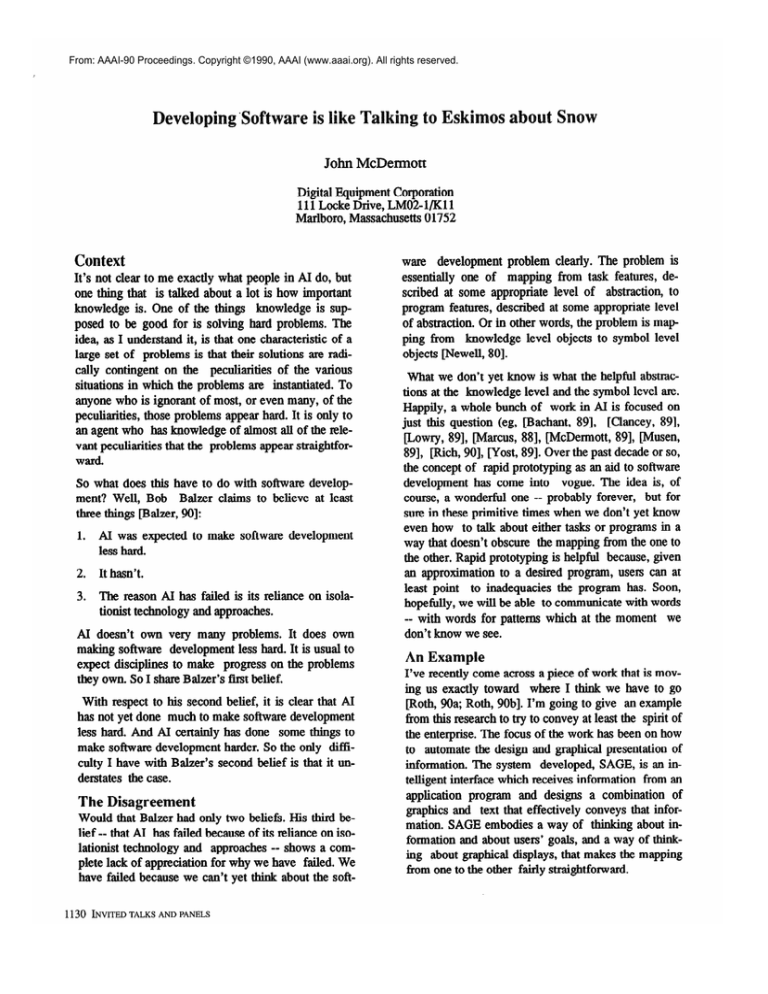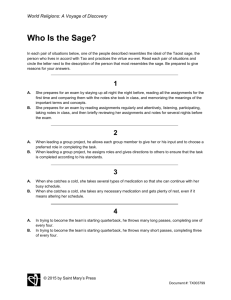
From: AAAI-90 Proceedings. Copyright ©1990, AAAI (www.aaai.org). All rights reserved.
eveloping ‘Softw re is like Talki
John McDermott
Digital Equipment Corporation
111 Locke Drive, LMOZl/Kl 1
Marlboro, Massachusetts 01752
Context
It’s not clear to me exactly what people in AI do, but
one thing that is talked about a lot is how important
knowledge is. One of the things knowledge is supposed to be good for is solving hard problems. The
idea, as I understand it, is that one characteristic of a
large set of problems is that their solutions are radically contingent on the peculiarities of the various
situations in which the problems are instantiated. To
anyone who is ignorant of most, or even many, of the
peculiarities, those problems appear hard. It is only to
an agent who has knowledge of almost all of the relevant peculiarities that the problems appear straightforward
So what does this have to do with software development? Well, Bob Balzer claims to believe at least
three things [Balzer, 901:
1.
AI was expected to make software development
less hard.
2.
It hasn’t.
3.
The reason AI has failed is its reliance on isolationist technology and approaches.
AI doesn’t own very many problems. It does own
making software development less hard. It is usual to
expect disciplines to make progress on the problems
they own. So I share Balzer’s first belief.
With respect to his second belief, it is clear that AI
has not yet done much to make software development
less hard. And AI certainly has done some things to
make software development harder. So the only difficulty I have with Balzer’s second belief is that it understates the case.
The Disagreement
Would that Balzer had only two beliefs. His third belief -- that AI has failed because of its reliance on isolationist technology and approaches -- shows a complete lack of appreciation for why we have failed. We
have failed because we can’t yet think about the soft1130
INVITED
TALKS AND PANELS
ware development problem clearly. The problem is
essentially one of mapping from task features, described at some appropriate level of abstraction, to
program features, described at some appropriate level
of abstraction. Or in other words, the problem is mapping from knowledge level objects to symbol level
objects [Newell, $01.
What we don’t yet know is what the helpful abstractions at the knowledge level and the symbol level are.
IIappily, a whole bunch of work in AI is focused on
just this question (eg, [Bachant, 891, [Clancey, 891,
Lowry, 891, warcus, 881, McDermott, 891, musen,
891, wch, 901, [Yost, 891. Over the past decade or so,
the concept of rapid prototyping as au aid to software
development has come into vogue. The idea is, of
course, a wonderful one -- probably forever, but for
sure in these primitive times when we don’t yet know
even how to talk about either tasks or programs in a
way that doesn’t obscure the mapping from the one to
the other. Rapid prototyping is helpful because, given
an approximation to a desired program, users can at
least point to inadequacies the program has. Soon,
hopefully, we will be able to communicate with words
-- with words for patterns which at the moment we
don’t know we see.
An Example
I’ve recently come across a piece of work that is moving us exactly toward where I think we have to go
moth, 90a; Roth, gob]. I’m going to give an example
from this research to try to convey at least the spirit of
the enterprise. The focus of the work has been on how
to automate the design and graphical presentation of
information. The system developed, SAGE, is an intelligent interface which receives information from an
application program and designs a combination of
graphics and text that effectively conveys that information. SAGE embodies a way of thinking about information and about users’ goals, and a way of thinking about graphical displays, that makes the mapping
from one to the other fairly straightforward.
Figure I Information
Provided to SAGE
Data
Activities
Activitv
Act- 1
Act-2
Act-4
.
Start-Date
34
2
30
..
Duration
4
12
4
..
End-Date
38
16
34
..
Resource
Sun
TI
Sun
..
Departments
Department
CAD-Dept
Structural-Dept
Assembly-Dept
Resoonsible- for
Act-l, Act-2, Act-4, ...
Act-19, Act-20, Act-23, ...
Act-33, Act-34, ...
Objects & Relations
Domain
Department
Activity
Activity
Activity
Characterization
Relation
Responsible-for
Start-date, End-date
Duration
Requires
of Objects
Object & Sets
Department
Activity
Resource
Date
Number-of-weeks
Characterization
Ordering
Nominal
Nominal
Nominal
Quantitative
Quantitative
Coverage
No
Yes
Yes
of Relationships
Relation&h
Interval
Characterization
Coordinate/Amount
-SW
mm
Coordinate
Amount
Domain
---Time
Time
of Relations
Relation
Responsible-for
Start-date, End-date, Duration
Requires
Characterization
Range
Activity
Date
Number-of-weeks
Resource
Cardinality
Varied
1
1
Uniuueness
Yes
No
No
Among Relations
Role
Beginning
Size
End
Relation
Start-date
Duration
End-date
of User’s Goals
Goal
Visualize-correlation
Relations
Responsible-for
Start-date, End-date
Duration
Requires
MCDERMOTT 1131
to SAGE come from a query to
Inthiscase,
nt database. ‘Ibe manager who
a project m
made the query was considering how to allocate coments for an upcoming prod included the departments
the activities they would be
startdates, end-dates, dusources. FQure 1, in addition to showing the information retrieved from the
project management database, contains a number of
SAGE attends to the following four kinds of task features:
1.
features which distinguish the kiuds of information each graphical technique can express,
2.
es based
features which order graphical tee
on how effective they are at conveying different
information,
3.
features which define users’ purposes,
4.
features which determine how information should
be integrated within a display.
&a
characterizations.
These data c.bimc~rizations
SAGE has a language for describing graphical displays
and information which it uses to automatically produce many complex, creative pictures through the
synthesis of simple techniques. Eigure 2 iilustrates the
kind of picture SAGE can compose. l?igure 1 displays
the input that allowed SAGE to compose that picture.
The example illustrates what it means to have helpful
abstractions at the knowledge level and at the symbol
level:
Figure 2 The Picture Produced by SAGE
Orgrnizrtlonal
Divfrlono
and Activlth
CAD-Dept
Act-l
Act-2
Act-4
Act-5
Wnkr
0
I
I
4
a
.
.
.
.
.
.
.
I1
8
.
.
.
.
.
.
.
I
12
I
.
.
.
.
.
.
.
I1
16
.
.
.
.
.
.
.
a
into
20
I
.
.
.
.
.
.
.
.
.
.
I
Project
24
I
.
.
.
.
.
.
.
.
.
.
*
26
.
.
.
.
.
.
.
.
.
.
.
Act-6
Act-8
Act-9
Act-10
Act-l 2
Structural-Dept
.
.
.
.
.
i&&q;
.
.
i;:.;:i.;R:i:~~::::::::‘
:.:::::::~::.::i:.:~:i:..::~
.:.‘r.:.:. .,:i..:.: :.‘_
.
.
.
.
.
.
.
.
.
.
.
.
.
.
;
.
.
.
.
;
.
.
.
.
.
32
I.
.
..
...
..
..
..
..
..
..
..
.
36
0
.
..
*
40
fi
.
I
44
n
.
..
..
..
..
..
...
..
..
...
.
:
..
...
..
..
...
..
.
..
U:
.
...
...
.
...
..
..
...
..
...
..
.
.
...
...
.
...
..
.
.
.
Act-19
Act-20
Act-22
Act-23
Act-24
Act-27
Assembly-Dept
Act-33
Act-34
Act-35
..
..
..
.
.
.
Act-43
Act-47
Act-50
Act-80
Act-8 1
Act-82
0
i
A&~.
..:.;.:.,.:
.;::s:i
.:: ;:
0
UiaoVAX
Sm
lbEaplocor
i
. . . . . . . . . . . . . . . . . . . . . . . . . . . . . . . . . . . . . . . . . . . . . . . ..~
1132 INVITED TALKS AND PANELS
--
information about what fatures of the task have relevance -- provide SAGE with precisely the information
it needs in order for it to exploit its knowledge of how
to compose pictures.
knowing that resources comprise nominal (unordered) sets and that number-of-weeks is quantitative enables SAGE to use color for the requires
relation, but not for the duration,
preparing ourselves for for decades. Now it’s time to
do something about it.
knowing that dates refer to time enables SAGE to
honor the convention that time is visualized horizontally, not vertically,
References
knowing that the responsible-for relation maps
“uniquely” to activities (ie, each activity is associated with one department) enables the hierarchical representation of the vertical axis,
knowing that the goal is to see the correlations
among all the relations leads SAGE to encode
them using different properties of a single graphical object: the color, vertical and horizontal position, and length of interval bars; (SAGE also can
infer that the bars’ vertical position reflects the
department associated with each activity),
knowing that start-date, end-date and duration
comprise an interval, enables SAGE to integrate
them as such in a single bar,
The knowledge that SAGE has that allows it to exploit
the data characterizations includes
constraint knowledge: for example, representing
resources using different shapes instead of colors
would have prevented display integration, because the interval bars are already constrained in
shape; SAGE considers spatial and other graphical constraints when searching for a way to integrate a picture,
picture organizational knowledge: for example, in
the absence of direct goals to the contrary, SAGE
used the order in which the relations were requested to determine that it should index (organize) the picture by department rather than by a
different property (eg, resource),
effectiveness knowledge: for example, SAGE
knows that color is good for distinguishing
among three resources, but not twenty.
Conclusion
AI almost has it within its grasp to make software development easier. Though it probably wouldn’t hurt if
we were less isolationist, the primary thing we need to
do is identify helpful abstractions for knowledge level
and symbol level objects so that program pieces can
identify and compose themselves on the basis of immediately salient characteristics of tasks. If we look at
our past just right, it’s clear this is work we’ve been
[Bachant, 891 Bachant, J., and E. Soloway. The Eugineering of XCON. Communication
of the ACM, 32,3,
1989.
palzer, 901 Balzer, R. AI and Software Engineering -will the Twain Ever Meet? Proceedings of the Eighth
Conference of the American Association for Artificial
Intelligence, Boston, Massachusetts, 1990 -- or if not
there, personal communication
[Clancey, 891 Clancey, W. J. The Knowledge Level
Reinterpreted: Modeling How Systems Interact. Machine Learning, 4,3/4,1989.
[Lowry, 891 Lowry M., and R. Duran. KnowledgeBased Software Engineering. Handbook of Artificial
Intelligence, Vol. 4, Addison-Wesley, 1989.
[Marcus, 881 Marcus, S. (ed). Automating Knowledge
Acquisition for Expert Systems. IUuwer, 1988.
NcDermott, 891 McDermott, J. The World Would Be
a Better Place if Non-Programmers Could Program.
Machine Learning, 4,314, 1989.
wusen, 891 Musen, M. Automated Support for Building and Extending Expert Models. Machine Learning,
4,3/4,1989.
wewell,
811 Newell, A. ‘Ihe Knowledge Level. Al
Magazine, 2,1,1981.
[Rich, 901 Rich, C., and R. Waters. The Programmer’s
Apprentice. Addison-Wesley, 1990.
[Roth, 9Oa] Roth, S. and J. Mattis. Automatic Graphic
Presentation for Production and Operations Management Systems. Proceedings of the Fourth International
Conference on Expert Systems, Hilton Head Island,
South Carolina, May, 1990.
@oth, 9Ob] Roth, S. and J. Mattis. Data Characterization for Intelligent Graphics Presentation. Proceedings
of the Conference on Computer Human Interaction,
Seattle, Washington, April, 1990.
post, 891 Yost, G. and A. Newell. A Problem Space
Approach to Expert System Specification. Proceedings
of the Eleventh International Joint Conference on Artificial Intelligence, Detroit, Michigan, 1989.
MCDERMOTT 1133





